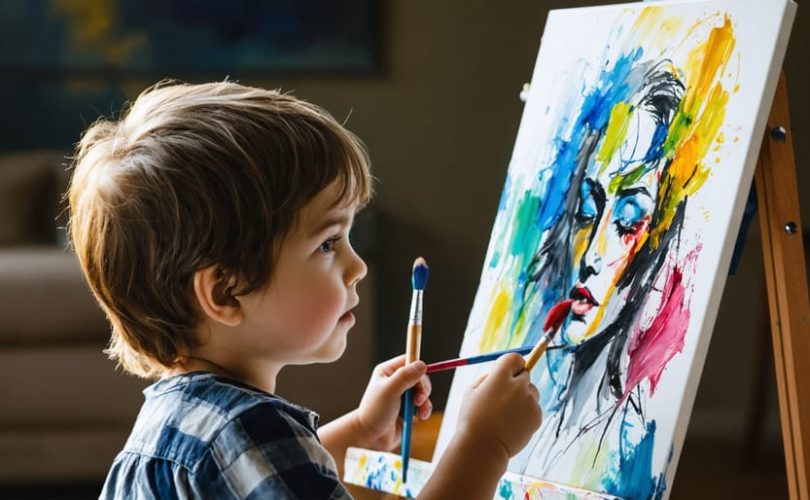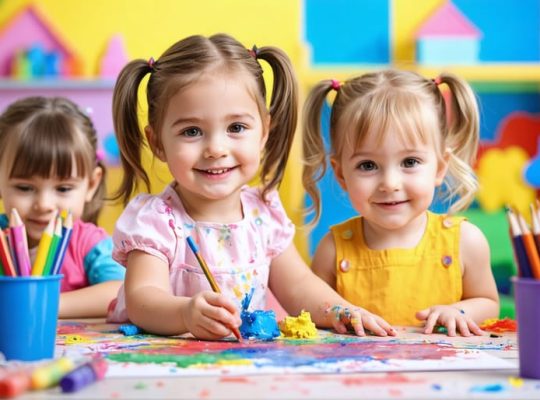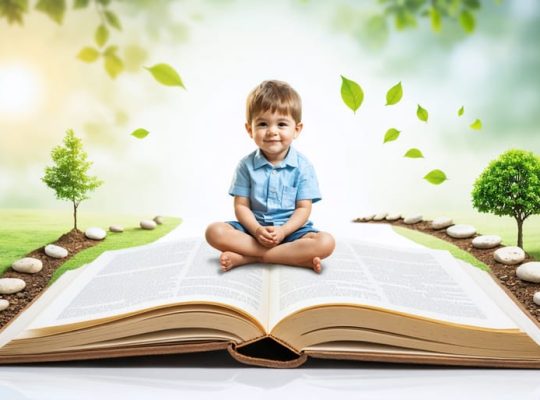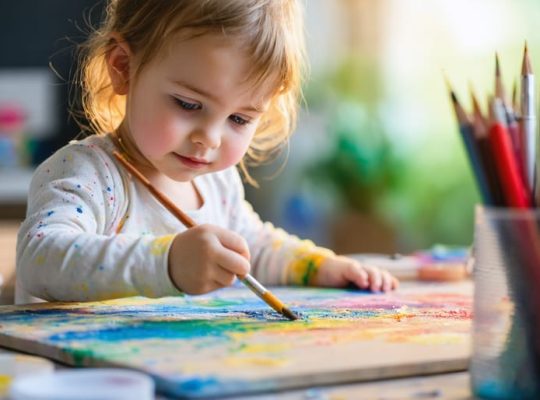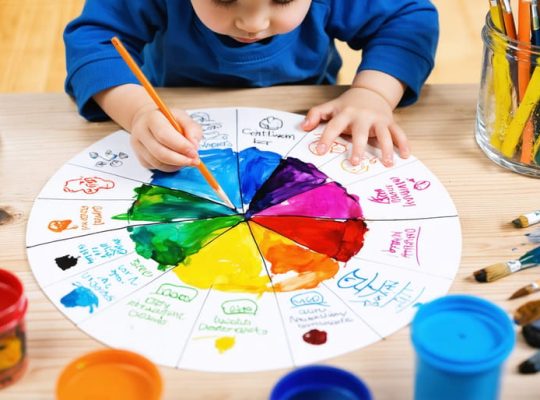When grief feels too heavy for words, visual expression becomes a powerful language of its own. Through drawings, paintings, and creative activities, children find unique ways to process complex emotions that might otherwise remain locked inside. Art therapy offers a gentle, non-threatening path for young minds to navigate the turbulent waters of loss.
Research shows that children often lack the vocabulary to articulate their grief verbally, but their artwork tells profound stories of love, loss, and healing. Whether through simple stick figures holding hands with absent loved ones or abstract splashes of color representing overwhelming feelings, these visual narratives provide crucial insights into a child’s emotional journey.
As parents and caregivers, understanding how to interpret and support these artistic expressions can transform moments of confusion into opportunities for connection and healing. By creating safe spaces for creative expression, we honor children’s natural instinct to process grief through visual storytelling, allowing them to move through loss at their own pace and in their own unique way.
Just as every child’s grief journey is different, their visual representations of loss will be uniquely their own – and that’s exactly as it should be.
Understanding Children’s Grief Through Art
Why Children Turn to Visual Expression
Children naturally gravitate toward visual expression when dealing with grief because it offers them a safe and intuitive way to express their feelings through art when words seem inadequate or overwhelming. Unlike adults, who might find comfort in talking about their emotions, children often lack the vocabulary or emotional maturity to verbalize complex feelings of loss and sadness.
Drawing, painting, or sculpting allows children to process their grief at their own pace, without the pressure of finding the “right words.” Through colors, shapes, and symbols, they can communicate their inner experiences in a way that feels natural and less threatening. Art becomes their voice when speaking becomes too difficult.
Dr. Sarah Thompson, a child psychologist, explains, “When children create art, they’re actually telling their story in a language they understand best. Their artwork often reveals emotions and thoughts they might not even realize they’re experiencing.” This natural inclination toward visual expression serves as a powerful healing tool, helping children navigate the complex journey of grief while maintaining a sense of control and safety in their expression.
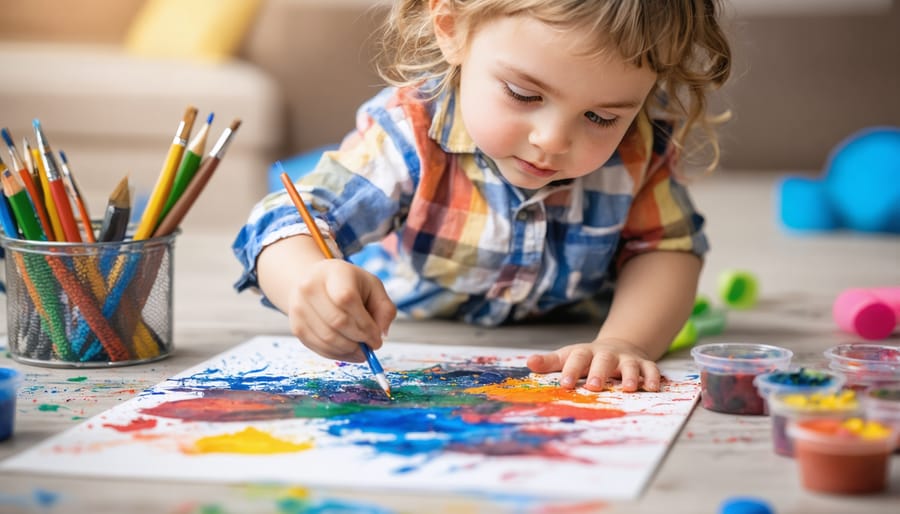
Common Visual Themes in Children’s Grief Art
When children express grief through art, certain visual elements frequently appear across different age groups and cultures. Hearts often symbolize love and connection to the lost loved one, while butterflies and birds represent transformation and spiritual themes. Dark colors like black and gray commonly express sadness, though bright colors might appear when depicting happy memories.
Many grieving children draw themselves with the deceased person, often holding hands or embracing. Some create physical separation in their artwork, such as drawing lines or barriers between figures, reflecting their understanding of loss. Weather elements like rain, storms, or sunshine can represent emotional states, while trees and flowers often symbolize growth and healing.
Family scenes are particularly common, with the absent person either included or notably missing from the picture. Some children use size to convey importance, drawing the deceased person larger than others. Angels, stars, and heavenly imagery frequently appear as children process spiritual aspects of loss. Abstract shapes and scribbles might represent complex emotions that children struggle to express in other ways.
Understanding these common themes helps caregivers better interpret and support children’s artistic expression of grief.
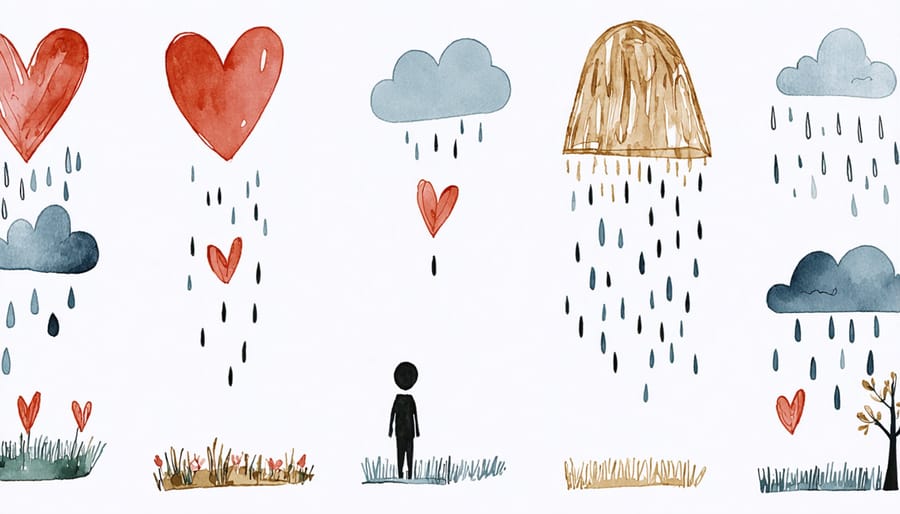
Art Activities That Help Process Grief
Memory Drawing and Painting
Memory drawing and painting offers a gentle pathway for children to explore and preserve precious memories of their loved ones. Through this creative process, children can capture specific moments, like drawing a favorite activity they shared or painting a place that holds special meaning. These artistic expressions serve as both a therapeutic outlet and a tangible connection to their memories.
Art therapist Sarah Martinez explains, “When children create memory-based artwork, they’re not just putting images on paper – they’re processing their experiences and building a visual legacy of their relationship with the person they’ve lost.”
Parents and caregivers can encourage this process by providing simple art supplies and offering gentle prompts like “Can you draw a happy time you remember?” or “What colors remind you of them?” Some children might choose to paint their loved one’s favorite flower garden, while others might draw themselves playing a cherished game together.
These artworks can become treasured keepsakes, helping children maintain an emotional connection while working through their grief. Creating a dedicated space to display these pieces, such as a memory wall or special album, can provide ongoing comfort and opportunities for conversation about their feelings and memories.
Remember that there’s no “right way” to create memory art – each child’s expression will be as unique as their relationship with their loved one and their grieving process.
Emotion Color Mapping
Colors play a powerful role in expressing the complex emotions that accompany grief. When children use creative visual tools to process their feelings, different colors often represent distinct emotional states.
Dark blues and greys frequently symbolize sadness and loneliness, while deep purples might express confusion or uncertainty about the future. Red often represents anger or frustration, emotions that commonly surface during the grieving process. Black, while sometimes avoided in therapeutic settings, can actually be a healthy way for children to express the heaviness of their loss.
Brighter colors also have their place in grief expression. Yellow might represent happy memories of the person who has passed, while green could symbolize hope and healing. White often represents peace or a sense of calm, which can emerge as children process their grief.
Art therapist Sarah Martinez shares, “When children choose colors to express their grief, they’re creating their own emotional language. There’s no right or wrong way to use colors – what matters is that the child feels safe expressing their authentic feelings.”
Parents and caregivers can encourage children to create their own color-emotion connections, allowing them to develop a personal vocabulary for expressing their grief journey. This approach helps validate their feelings while providing a concrete way to communicate complex emotions.
Safe Space Creation
Creating a safe and comforting environment through art can help children process their grief more effectively. One powerful approach is the “Grief Corner” project, where children design and decorate their own special space using materials that bring them comfort. This might include favorite colors, soft fabrics, family photos, or meaningful drawings.
Memory boxes are another valuable tool, allowing children to transform simple containers into personalized sanctuaries for keeping precious mementos of their loved ones. Children can paint, collage, or decorate these boxes while sharing stories and memories, making the creative process itself therapeutic.
The “Comfort Blanket Collage” activity involves creating a paper or fabric collage representing things that make the child feel safe and supported. This might include pictures of family members, pets, favorite activities, or peaceful places. The finished piece can serve as a visual reminder of their support system during difficult moments.
Creating “Emotion Gardens” allows children to express their feelings through nature-themed artwork. They might draw or craft different flowers, each representing various emotions they’re experiencing. This gives them a concrete way to identify and process complex feelings while creating something beautiful.
These safe space projects not only provide creative outlets but also help children understand that it’s okay to seek comfort and express their grief in their own unique ways. The finished artworks serve as tangible tools they can turn to whenever they need emotional support.
Supporting Your Child’s Artistic Expression
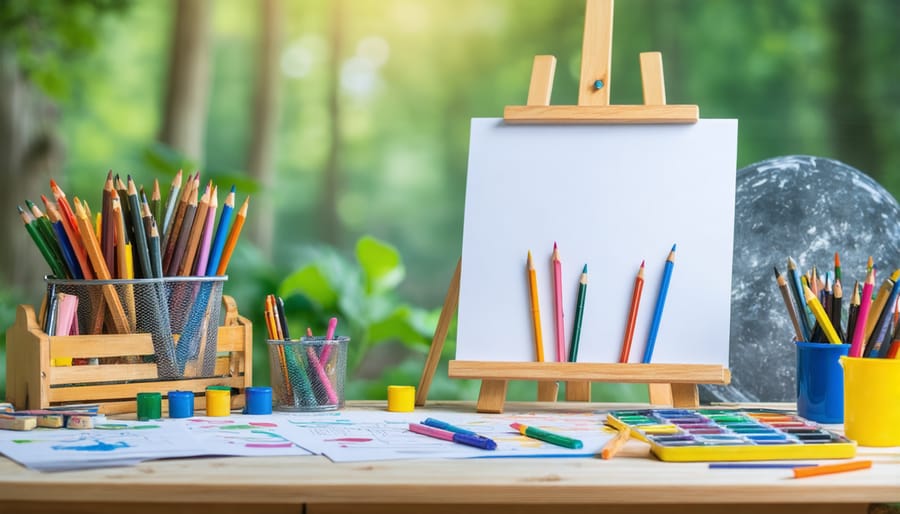
Creating a Supportive Environment
Creating a safe and nurturing environment is essential when helping children express their grief through art. Start by designating a quiet, comfortable space where children can focus on their creative activities for emotional processing without interruption.
Keep art supplies well-organized and easily accessible. Stock the area with various materials like colored pencils, markers, paint, clay, and paper of different sizes. This variety allows children to choose mediums that best match their emotional needs and comfort level.
Natural lighting is ideal, but soft artificial lighting works well too. Consider playing gentle background music if it helps create a calming atmosphere. Make sure there’s enough table space for children to spread out their work, and provide comfortable seating that allows them to stay focused for extended periods.
Display encouraging messages or previous artwork on the walls to inspire confidence, but leave plenty of blank space to avoid overwhelming the senses. Keep tissues nearby, as artistic expression can trigger emotional releases. Remember to respect privacy – some children prefer to create alone, while others might want company.
Most importantly, maintain a judgment-free zone where children feel safe expressing their feelings through art. Let them know there’s no “right” or “wrong” way to create, and their artistic choices are valid expressions of their grief journey.
Responding to Difficult Images
When children create artwork that depicts intense emotions or disturbing imagery, it’s important to respond thoughtfully and supportively. Start by remaining calm and avoiding immediate negative reactions, as this could discourage the child from future emotional expression.
Ask open-ended questions about their artwork, such as “Can you tell me about your drawing?” or “What made you choose these colors?” This approach allows children to explain their thoughts and feelings in their own words. Remember that dark or seemingly violent imagery doesn’t necessarily indicate a problem – it may be a healthy way of processing difficult emotions.
If the artwork consistently shows concerning themes, document these pieces and consider consulting with a child mental health professional. They can provide expert guidance on whether the content reflects normal grief processing or requires additional support.
Create a safe space for artistic expression by:
– Acknowledging their feelings without judgment
– Offering comfort and reassurance
– Maintaining regular check-ins about their emotions
– Providing appropriate art materials and dedicated time for expression
– Being present and available to talk when they’re ready
Sometimes, suggesting alternative ways to express similar feelings can help, such as using different colors, shapes, or creating a series of images that show their journey through grief. Always validate their experience while gently guiding them toward healthy expression methods.
When to Seek Professional Help
While art can be a powerful tool for processing grief, there are times when professional support becomes essential. Watch for signs that indicate your child might benefit from professional art therapy or counseling.
Pay attention if your child’s artwork consistently shows disturbing or violent themes, extreme darkness, or isolation. While some difficult emotions are normal in grief expression, persistent concerning imagery may signal deeper struggles.
Notice changes in their artistic behavior too. A child who suddenly stops creating art altogether, or one who becomes obsessed with repeatedly drawing the same traumatic scene, might need additional support. Similarly, if their artwork shows no emotional progression over several months, this could indicate they’re stuck in their grief journey.
Other warning signs include:
– Intense emotional reactions while creating or discussing their artwork
– Complete withdrawal from other activities they usually enjoy
– Artwork that reveals thoughts of self-harm or hopelessness
– Inability to express any positive memories or emotions about their loss
– Extreme anxiety about making “mistakes” in their grief-related art
Remember, seeking professional help isn’t a sign of failure. Many art therapists specialize in child grief and can provide expert guidance while maintaining the safe, creative environment your child needs. They can help interpret the visual symbols in your child’s artwork and develop targeted therapeutic strategies.
Trust your instincts as a caregiver. If you’re concerned about your child’s grief expression through art, consulting with a mental health professional can provide valuable insights and support for both you and your child.
The journey through grief is deeply personal, and art provides a powerful pathway to healing that transcends words. Through visual representation, both children and adults can find solace, understanding, and a means to express emotions that might otherwise remain locked inside. As we’ve explored throughout this article, the creative process offers a safe space for processing loss and remembering loved ones.
Remember that there is no “right” way to grieve or create art. Each person’s expression is valid and meaningful, whether it’s through simple drawings, elaborate paintings, or collaborative memory projects. The healing power of art lies not in artistic skill but in the authentic expression of feelings and memories.
For parents, teachers, and caregivers supporting grieving individuals, continue to provide opportunities for artistic expression while respecting personal boundaries and timing. Create a supportive environment where emotions can be freely expressed through various creative mediums. Consider joining support groups or working with art therapists who can provide additional guidance and resources.
As we move forward, let’s remember that grief doesn’t follow a timeline, and neither does healing. Art remains a constant companion in this journey, offering comfort and connection when words fall short. By embracing visual representation as a tool for processing grief, we open doors to healing, understanding, and ultimately, hope for the future.

